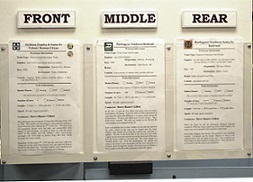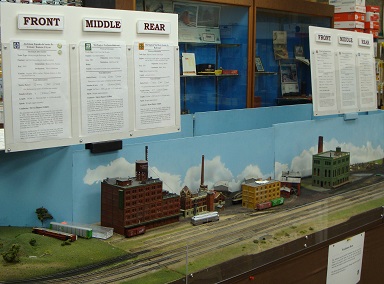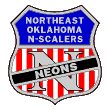The
NEONS (Northeast Oklahoma N-Scalers) N-Trak club enjoys setting up its layout at train shows and running a
variety of trains. Many of the trains we run are 80 to 120 cars long and are great crowd pleasers. The most frequently
asked questions are: “How long is the train?”, “How many cars are in it?” and “Are all those engines real and does it
really take all of them to pull the train?”
A few years ago the
NEONS developed “Signboards” for all our N-Trak modules that explained what each module was about.
These Signboards were printed on heavy-duty 8½” x 11” card stock and are mounted on the front of each module. They explain
each diorama, indicating if the module depicts an Oklahoma scene, a Route 66 scene and/or any specific railroad’s tracks.
We’ve received many compliments on our Signboards from the public and members of other clubs.
As a response to the frequent questions about the trains that are running, and using the success of our Signboards as an
incentive, we developed the concept of “Trainboards” which are 8½” x 14” printed sheets that answer these questions and
more. Similar to our module Signboards, a Trainboard describes each train that is running on the layout and is posted
just above the layout’s skyboards so it can easily be read by the public.
The objective of this exercise is two-fold. First, it attracts the attention of the public which will, hopefully, spur
the interest of some observers and plant a seed that may grow and blossom into new model railroaders. Second, it gives
us an opportunity to add a new dimension to our modeling experience, affording us the chance to personalize our trains
by researching and learning a little more about railroad history and then to sort and assemble our inventory of engines
and rolling stock into not just model trains, but train models.

Each Trainboard is divided into three sections. Section one provides information about the prototype that is being
modeled. This data includes the type of train, its name (if it has one), what time era it represents, the train’s
route, what engines are pulling it and what kind of cars are in its consist. Section two contains details about the
model. Train specs include model engine manufacturer, whether the engines are analog or DCC, decoder brand and if
sound equipped, the actual and scale length of the train, the number of cars, the train’s approximate scale speed and,
most importantly, to whom it belongs. Section three contains an informative narrative regarding the train, the railroad,
the era, and/or explains why that train exists and how it provides a service.

We have two, three-slot Trainboard displays. The slots are sandwiched between a large piece of foam board and a thin
sheet of Plexiglas. Individual Trainboards are simply dropped into the slots and can easily be pulled out. Above each
slot is a label indicating the track on which that train is running. Because the red line is usually part of the Red
Line Route™ and therefore not exclusive to
NEONS trains, we do not normally display info on trains running along the
red line. When it is a member’s time to run a train, he/she inserts the appropriate Trainboard into the proper slot
and then powers that train onto the layout.
For example, with a little research I discovered that Santa Fe operated the Tulsan between KC and Tulsa from 1939 up
into the ‘70s. In the early years it was a daytime heavyweight pulled by steam. Couple a standard, out-of-the-box,
Con-Cor set of heavyweight Santa Fe passenger cars with a Bachmann Consolidation (or other) Santa Fe steam engine and
all of a sudden, this nondescript little passenger train becomes the ATSF Tulsan and the public can relate to it. Sure,
detail oriented model railroaders can find some inaccuracies and discrepancies between the model and the prototype, but
for the most part, it is a reasonable representation, particularly in the eyes of the general public.
In the ‘30s and ‘40s the New York Central Railroad used their iconic Dreyfuss streamlined J3a Hudson locomotives to pull
several of their regularly scheduled passenger trains. These trains were called “Meteor” trains. Just as with the Tulsan,
a six-car set of Con-Cor heavyweights in the NYC livery pulled by Con-Cor’s model of a Dreyfuss Hudson becomes a NYC Meteor
train such as the Detroit Meteor or the James Whitcomb Riley, and just like the Tulsan, is a reasonably prototypical model.
You can take a mixed freight train pulled by any given railroad’s engines, define where along that railroad’s system the
train is running, match the vintage of the cars to the vintage of the engines and instantly, you have a train that can
be described on a Trainboard. Prepare a small spiel about the railroad’s history in relation to this particular train
and again, you have something that will grab the public’s attention. Attached are several examples of Trainboards.
Look at any of the “Fast Freight” examples for ideas on how to define yours.
Trainboards can also be easily prepared for fantasy trains. Take a look at the Smokey Bear, Hershey’s Chocolate and
Beer Train Trainboards for ideas.
NEONS has
low-definition heralds for many railroads that can be copied
and pasted to your Trainboard. Drumheads of most named passenger trains can be found on-line. Check the
Tomar website for many of them.
Most model railroaders buy additional rolling stock now and then, so their trains grow over time. You may not be able to
finalize the number of cars in any given train, or the length of that train until just a few weeks before the show. When
you consider that while running a train, the operator often has to remove one or two problem cars to make the consist
function trouble-free, the resulting train will probably have fewer cars and be shorter than what is shown on the
Trainboard anyway. So if the Trainboard data isn’t exact, but is close, then that should suffice. We do keep a
Sharpie handy so updates can be posted if the operator so desires.




